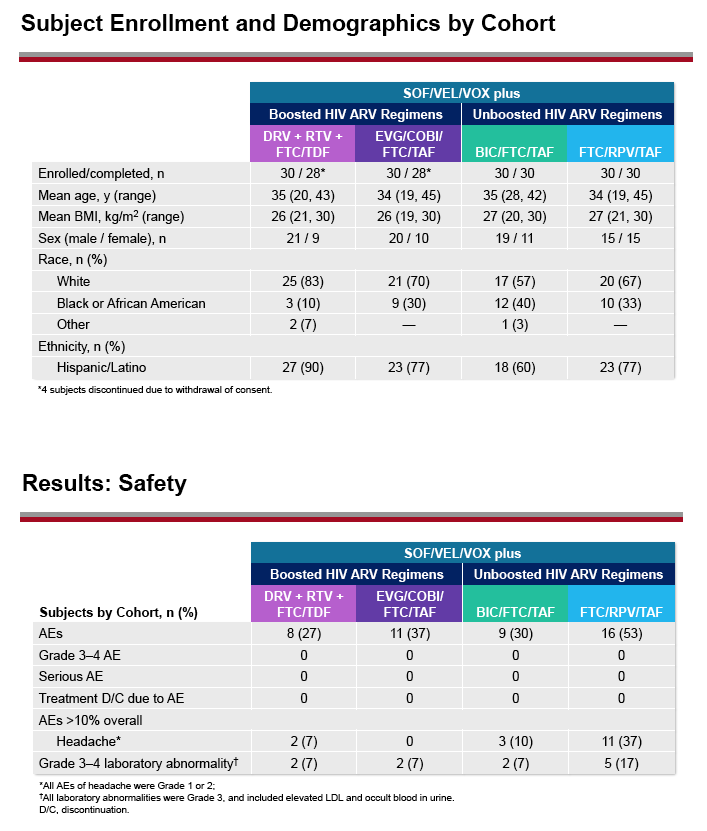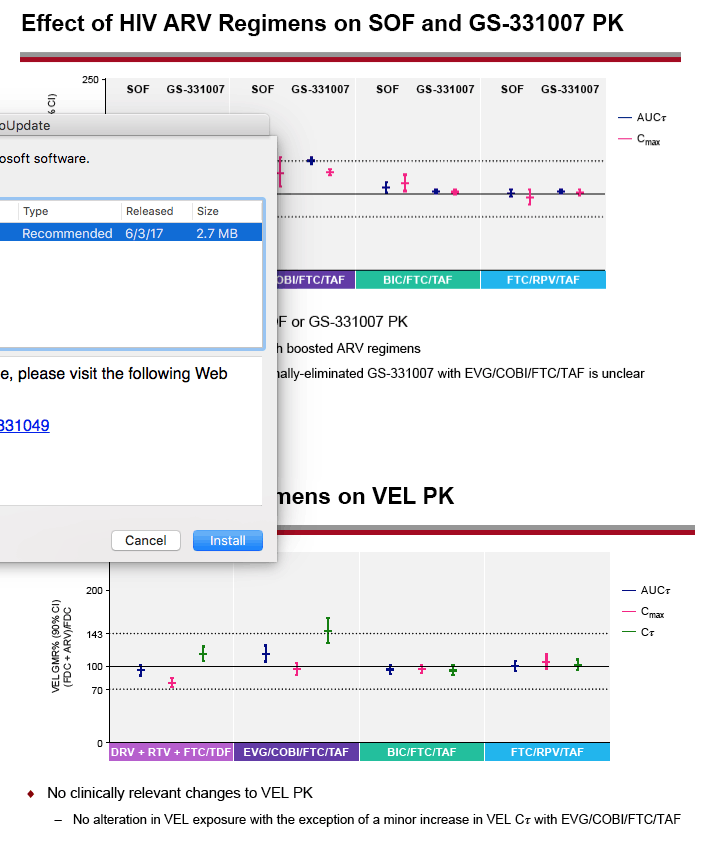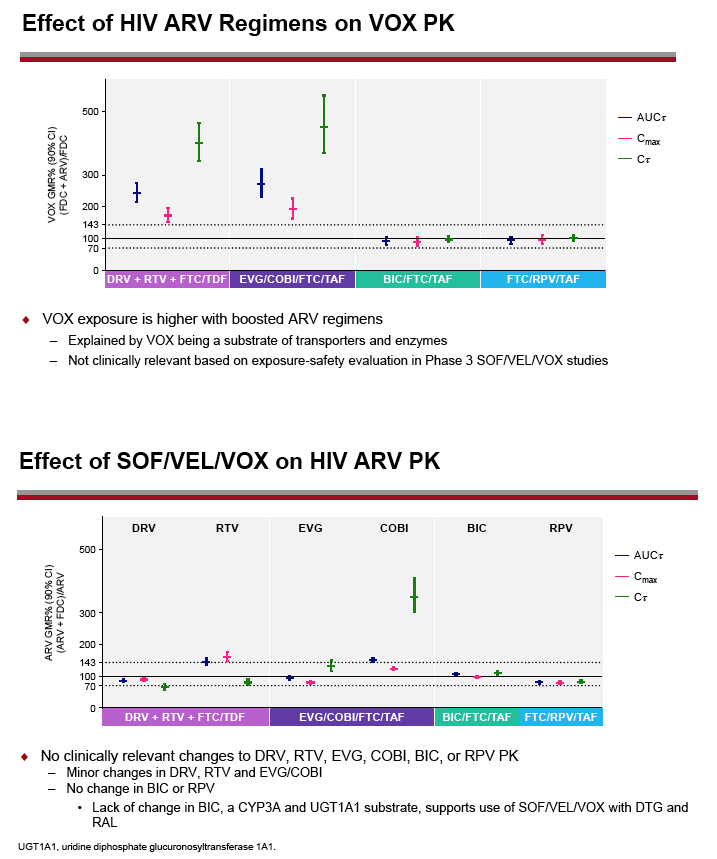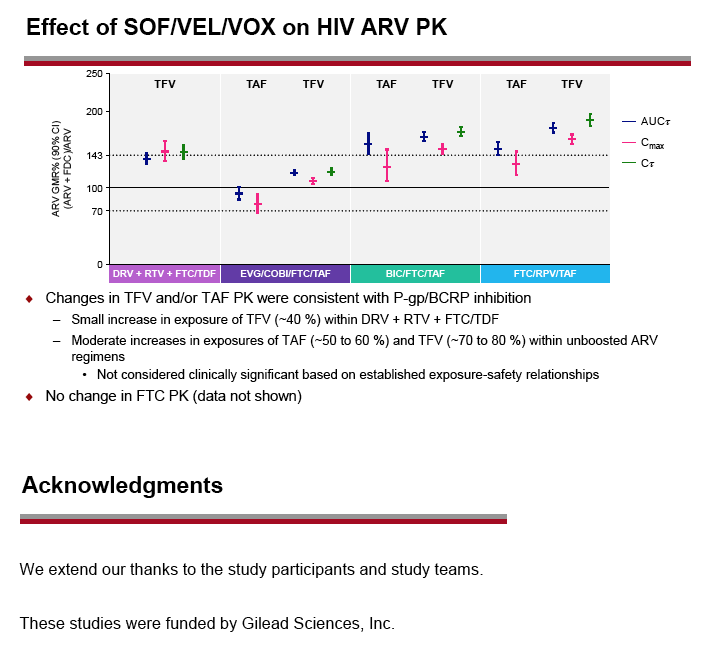 |
 |
 |
| |
Evaluation of Drug-Drug Interactions Between Sofosbuvir/Velpatasvir/Voxilapevir and Boosted or Unboosted HIV Antiretroviral Regimens - report 2
|
| |
| |
Higher Voxilaprevir Levels With COBI/RTV-Boosted Antiretrovirals
18th International Workshop on Clinical Pharmacology of Antiviral Therapy, June 14-17, 2017, Chicago
Mark Mascolini
Exposure of voxilaprevir, a direct-acting antiviral (DAA) combined with sofosbuvir and velpatasvir as a fixed-dose anti-HCV agent, proved higher with antiretrovirals boosted by cobicistat (COBI) or ritonavir (RTV) in healthy volunteers [1]. Antiretrovirals did not affect levels of sofosbuvir or velpatasvir, and the three DAAs had no clinically relevant impact on the antiretrovirals studied.
A once-daily DAA coformulation combining sofosbuvir (an NS5B inhibitor), velpatasvir (an NS5A inhibitor), and voxilaprevir (an NS3/4A protease inhibitor) is being studied for treatment of chronic HCV infection [2]. Gilead investigators analyzed phase 1 data from trials in healthy volunteers to assess potential interactions between each of the DAAs and components of common antiretroviral regimens. They also measured levels of GS-331007, the principal circulating metabolite of sofosbuvir.
In these multiple-dose crossover trials, participants took sofosbuvir/velpatasvir/voxilaprevir at a dose of 400/100/100 mg daily plus an extra 100 mg of voxilaprevir to approximate higher levels seen in HCV patients than in healthy volunteers. The antiretroviral combinations were the investigational integrase inhibitor bictegravir plus emtricitabine/tenofovir alafenamide (FTC/TAF) (50/200/25 mg), FTC/rilpivirine/TAF (200/25/25 mg), elvitegravir/COBI/FTC/TAF (150/150/200/10 mg), and darunavir (800 mg) + RTV (100 mg) + FTC/tenofovir disoproxil fumarate (TDF) (200/300 mg). The Gilead team used geometric least-squares means ratios to compare levels of antiretrovirals and DAAs combined versus alone. They set no-interaction boundaries at 70% to 143%.
The analysis involved 120 volunteers (30 per cohort), and all but 4 completed the studies. The 4 dropouts withdrew consent. Most adverse events were grade 1 or 2. There were no serious adverse events, and no one stopped treatment because of adverse events.
No antiretroviral combinations studied affected sofosbuvir or velpatasvir area under the concentration-time curve (AUC). AUC of GS-331007 was 43% higher with elvitegravir/COBI/FTC/TAF. Antiretrovirals not boosted by COBI or RTV did not affect voxilaprevir AUC. But voxilaprevir AUC was 143% to 171% higher with COBI- or RTV-boosted regimens.
Coadministration with the DAAs did not substantially affect AUC of bictegravir, FTC, rilpivirine, darunavir, or elvitegravir. When given with the DAAs, COBI and RTV reached AUCs 50% and 45% higher than when given alone. When given in unboosted regimens, TAF and tenofovir had AUCs 52% to 58% higher and 67% to 79% higher with the DAAs. As part of darunavir/RTV/FTC/TDF, tenofovir reached an AUC 39% higher with the DAAs. As part of elvitegravir/COBI/FTC/TAF, TAF and tenofovir levels did not change with the DAAs.
The Gilead researchers concluded that these pharmacokinetic findings support coadministration of the three-DAA coformulation with the nucleos(t)ides FTC, TAF, and TDF, the nonnucleoside rilpivirine, the integrase inhibitors bictegravir, dolutegravir, elvitegravir, and raltegravir, the protease inhibitor darunavir, and the boosters cobicistat and ritonavir.
References
1. Garrison K, Mogalian E, Zhang H, et al. Evaluation of drug-drug interactions between sofosbuvir/velpatasvir/voxilaprevir and boosted or unboosted HIV antiretroviral regimens. 18th International Workshop on Clinical Pharmacology of Antiviral Therapy, June 14-17, 2017, Chicago. O_20.
2. Bourliere M, Gordon SC, Flamm SL, et al. Sofosbuvir, velpatasvir, and voxilaprevir for previously treated HCV infection. N Engl J Med. 2017;376:2134-2146.
--------------------
Evaluation of Drug-Drug Interactions Between Sofosbuvir/Velpatasvir/Voxilapevir and Boosted or Unboosted HIV Antiretroviral Regimens







|
| |
|
 |
 |
|
|